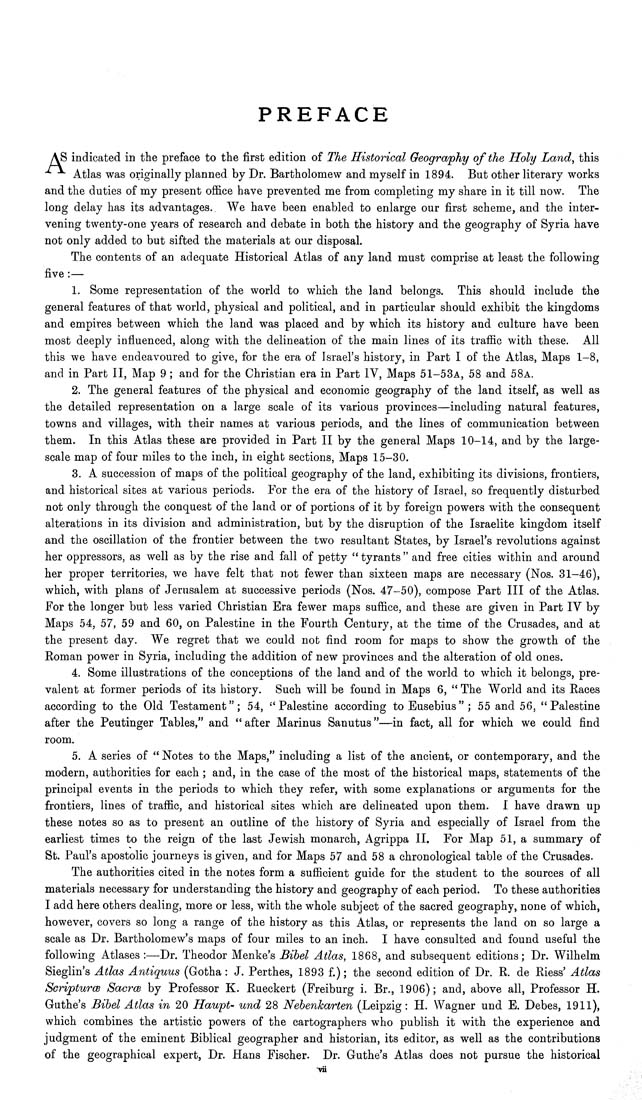PREFACE
AS indicated in the preface to the first edition of The Historical Geography of the Holy Land, this
Atlas was originally planned by Dr. Bartholomew and myself in 1894. But other literary works
and the duties of my present office have prevented me from completing my share in it till now. The
long delay has its advantages. We have been enabled to enlarge our first scheme, and the inter¬
vening twenty-one years of research and debate in both the history and the geography of Syria have
not only added to but sifted the materials at our disposal.
The contents of an adequate Historical Atlas of any land must comprise at least the following
five :—
1. Some representation of the world to which the land belongs. This should include the
general features of that world, physical and political, and in particular should exhibit the kingdoms
and empires between which the land was placed and by which its history and culture have been
most deeply influenced, along with the delineation of the main lines of its traffic with these. All
this we have endeavoured to give, for the era of Israel's history, in Part I of the Atlas, Maps 1-8,
and in Part II, Map 9 ; and for the Christian era in Part IV, Maps 51-53a, 58 and 58a.
2. The general features of the physical and economic geography of the land itself, as well as
the detailed representation on a large scale of its various provinces—including natural features,
towns and villages, with their names at various periods, and the lines of communication between
them. In this Atlas these are provided in Part II by the general Maps 10-14, and by the large-
scale map of four miles to the inch, in eight sections, Maps 15-30.
3. A succession of maps of the political geography of the land, exhibiting its divisions, frontiers,
and historical sites at various periods. For the era of the history of Israel, so frequently disturbed
not only through the conquest of the land or of portions of it by foreign powers with the consequent
alterations in its division and administration, but by the disruption of the Israelite kingdom itself
and the oscillation of the frontier between the two resultant States, by Israel's revolutions against
her oppressors, as well as by the rise and fall of petty ''tyrants'' and free cities within and around
her proper territories, we have felt that not fewer than sixteen maps are necessary (Nos. 31-46),
which, with plans of Jerusalem at successive periods (Nos. 47-50), compose Part III of the Atlas.
For the longer but less varied Christian Era fewer maps suffice, and these are given in Part IV by
Maps 54, 57, 59 and 60, on Palestine in the Fourth Century, at the time of the Crusades, and at
the present day. We regret that we could not find room for maps to show the growth of the
Eoman power in Syria, including the addition of new provinces and the alteration of old ones.
4. Some illustrations of the conceptions of the land and of the world to which it belongs, pre¬
valent at former periods of its history. Such will be found in Maps 6, '' The World and its Eaces
according to the Old Testament"; 54, ''Palestine according toEusebius"; 55 and 56, "Palestine
after the Peutinger Tables," and "after Marinus Sanutus"—in fact, all for which we could find
room.
5. A series of " Notes to the Maps," including a list of the ancient, or contemporary, and the
modern, authorities for each ; and, in the case of the most of the historical maps, statements of the
principal events in the periods to which they refer, with some explanations or arguments for the
frontiers, lines of traffic, and historical sites which are delineated upon them. I have drawn up
these notes so as to present an outline of the history of Syria and especially of Israel from the
earliest times to the reign of the last Jewish monarch, Agrippa II. For Map 51, a summary of
St. Paul's apostolic journeys is given, and for Maps 57 and 58 a chronological table of the Crusades.
The authorities cited in the notes form a sufficient guide for the student to the sources of all
materials necessary for understanding the history and geography of each period. To these authorities
I add here others dealing, more or less, with the whole subject of the sacred geography, none of which,
however, covers so long a range of the history as this Atlas, or represents the land on so large a
scale as Dr. Bartholomew's maps of four miles to an inch. I have consulted and found useful the
following Atlases :—Dr. Theodor Menke's Bihel Atlas, 1868, and subsequent editions; Dr. Wilhelm
Sieglin's Atlas Antiquus (Gotha : J. Perthes, 1893 f.); the second edition of Dr. R. de Riess' Atlas
ScripturcB Sacrce by Professor K. Rueckert (Freiburg i. Br., 1906); and, above all, Professor H.
Guthe's Bibel Atlas in 20 Haupt- und 28 Nehenkarten (Leipzig : H. Wagner und E. Debes, 1911),
which combines the artistic powers of the cartographers who publish it with the experience and
judgment of the eminent Biblical geographer and historian, its editor, as well as the contributions
of the geographical expert, Dr. Hans Fischer. Dr. Guthe's Atlas does not pursue the historical
|








